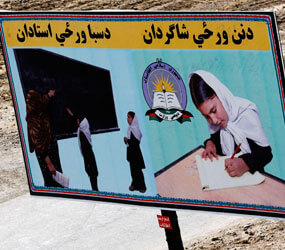RADNOR, Pa. – After 30 years of war and repressive rule of the Taliban, today only 28 percent of the people in Afghanistan can read and write and 18 percent of them are women and girls, according to Catholic Relief Services representatives visiting the Philadelphia Archdiocese.
Michaela Egger, education program coordinator for CRS Afghanistan, and two of her Afghan colleagues visited the Philadelphia Archdiocese recently to meet with donors and promote education and other components of the agency’s strategic plan for Afghanistan.
The three reps said that since the fall of the Taliban in 2001, more than 6.5 million children have enrolled in school, and about one-third of those students are girls. Afghan citizens thirst for education and are willing to work hard to secure it, they added.
Traveling around the United States until about mid-May, Egger and her two colleagues hoped that in addition to addressing the state of education in Afghanistan, they could change negative stereotypes they feel Americans have of the country.
Egger, 31, is from Our Lady of Mercy Parish in Park Ridge, N.J., which is in the Newark Archdiocese. In Afghanistan 96 percent of the 400 CRS staff members are native born.
CRS is the U.S. bishops’ overseas relief and development agency.
During the CRS reps’ visit to Merion Mercy Academy, a private all-girls high school in Merion Station, they asked the students what words came to mind when they heard “Afghanistan.”
Responses included “terrorism,” “turmoil” and “war.”
In reality, “there’s a thirst for peace, for education, for learning and for that awareness to be shared with others,” Egger said. “Afghans would also like others outside Afghanistan to perceive them as peaceful, as wanting education, as supporting their children.”
In sharing the struggles of generations of Afghan women who were deprived of a formal education, Egger and her colleagues urged Merion Mercy students never to take their education for granted. They also encouraged the students to share what they have learned about Afghanistan with others.
The three CRS reps also met with administrators and other representatives of Cabrini College in Radnor, one of the agency’s college partners.
Since 2003, CRS Afghanistan has worked to expand quality learning opportunities for marginalized communities and their children.
CRS has maintained a long-term strategy based on a community education model and supports efforts initiated by many rural communities throughout Afghanistan to provide basic education to children who cannot access formal, government-supported schools.
The community-based education model utilizes a national educational curriculum.
CRS’ community-based strategy promotes grass-roots advocacy and support for education through parent teacher organizations; early childhood development for disadvantaged pre-primary students; a primary school system; accelerated learning for teenagers and young women denied access to education under the Taliban regime; and community libraries that provide learning materials in rural areas.
In some rural communities, “now that there is a literate generation of children, it’s possible for children to take books home and read them to their parents or to the wider family,” Egger said. “In some communities, informal women’s study groups have formed.”
Roughly 12,400 students – 60 percent of whom are girls – are participating in CRS efforts in 340 rural communities in 14 districts across four provinces: Kapisa, Panjshir, Herat and Ghor.
In all her work, Egger said she is mindful of a sentiment expressed to her by an Afghan teacher: “He said, ‘A lot of organizations have come to our village over the past few years and a lot of them have given us different materials. But after a while, those materials and organizations go away. But when somebody gives us knowledge, that’s the most useful thing that we can receive because that’s something that can never be taken away from us.’ ”


